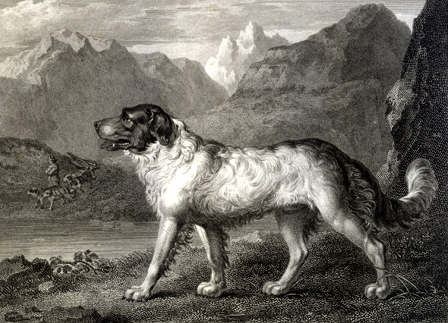[ Taplin / The Sportsman's Cabinet; or, A Correct Delineation of the Various Dogs Used in the Sports of the Field... by a Veteran Sportsman ]
The "Veteran Sportsman" is believed to William Taplin (1740? - 1807), who wrote extensively about hunting and horses.
There is indeed a 2-volume work with this title published not in 1802, as is sometimes noted, but in 1803/1804. The Newfoundland is apparently discussed in the first volume, which I have not been able to find online; the second volume has nothing to say about Newfoundlands. What follows below is taken from the wonderful Discovering Lewis and Clark website.
The illustration is an engraving, by John Scott (1774 - 1827), a noted English engraver and printmaker, of a painting by Philip Reinagle.
Docile beyond conception, and affectionate beyond description, the Newfoundland dog is easily taught almost every thing within the power of the human mind to inculcate, of which his own strength and frame are capable. Equally sagacious as energetic, he patiently perseveres in whatever he undertakes, and never relinquishes the attempt so long as there remains the most distant hope, or possibility of success....The sagacity of this animal is so palpably blended with a peculiarly attentive attachment to the human species, and such an instantaneous sense of impending danger, that the inactive mind, lulled to an apathy, becomes immediately roused to action in the contemplation. (72-73)
Another Newf-related passage from this work is quoted by several subsequent writers; here it is from Hugh Dalziel's 1879 British Dogs, also treated here at The Cultured Newf:
The dog passing under this description is so universally known in every part of the kingdom, and is so accurately delineated by the united efforts of the artists in the representation annexed, that a minute description of its size, shape, make, and formmay be considered unnecessary. . . . He is one of the most majestic of all the canine variety. Although at first sight he appears terrific from the immensity of his magnitude, the placid serenity of his countenance as instantly dispels the agitating vibrations of fear.
There is some speculation that this painting was based on George Stubbs' Portrait of a Newfoundland Dog, exhibited in 1803; see Hugh Belsey, "A Newfoundland dog by George Stubbs," Burlington Magazine 129 (Nov. 1987): 736. Yet William Secord, the noted authority on dog paintings, states that this is a portrait of a Newfoundland named Bell (Dog Painting 1840 - 1940: A Social History of the Dog in Art [Antique Collector's Club: Woodbridge, Suffolk, UK: 1992], p. 205). He does not provide a source for this information.
From the excellent Discovering Lewis and Clark website.

